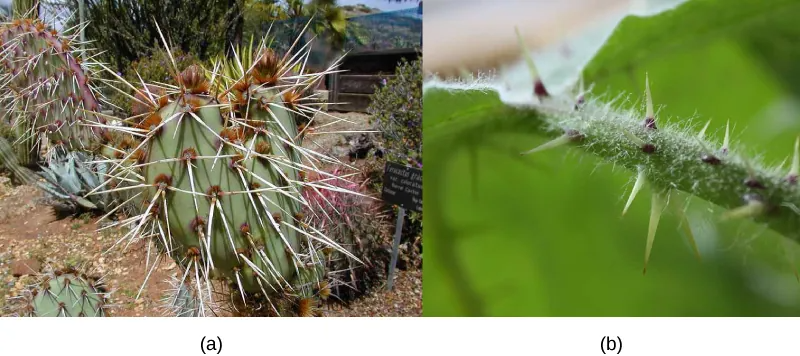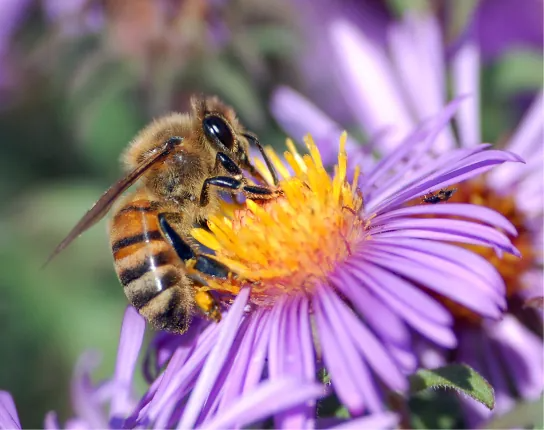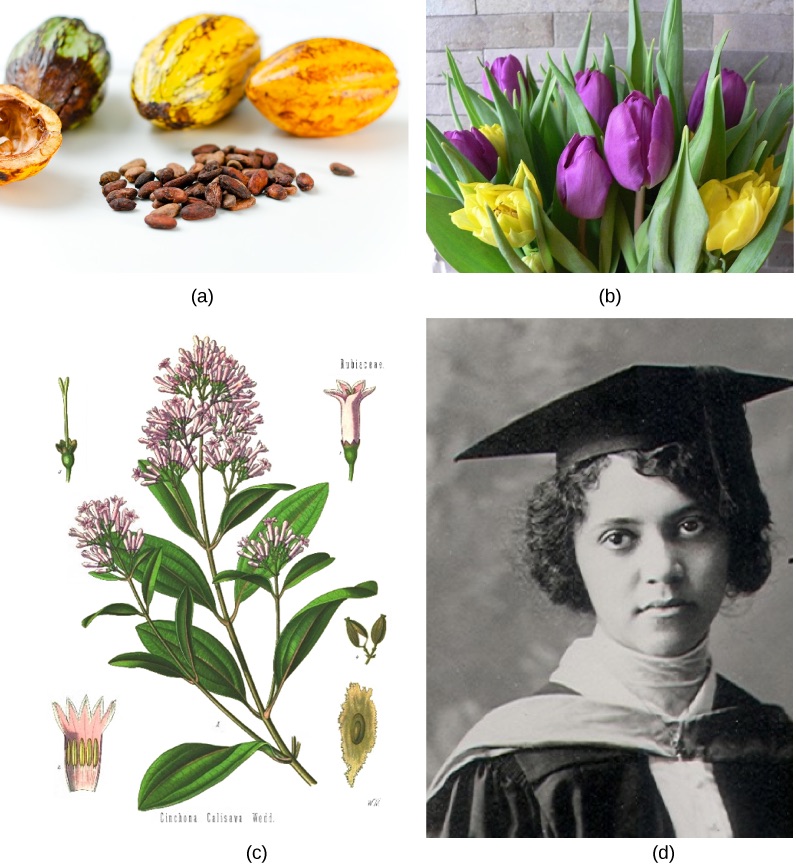26.4 The Role of Seed Plants
Learning Objectives
- Explain how angiosperm diversity is due, in part, to multiple complex interactions with animals
- Describe ways in which pollination occurs
- Discuss the roles that plants play in ecosystems and how deforestation threatens plant biodiversity
Without seed plants, life as we know it would not be possible. Plants play a key role in the maintenance of terrestrial ecosystems through the stabilization of soils, cycling of carbon, and climate moderation. Large tropical forests release oxygen and act as carbon dioxide “sinks.” Seed plants provide shelter to many life forms, as well as food for herbivores, thereby indirectly feeding carnivores. Plant secondary metabolites are used for medicinal purposes and industrial production. Virtually all animal life is dependent on plants for survival.
Animals and Plants: Herbivory
Coevolution of flowering plants and insects is a hypothesis that has received much attention and support, especially because both angiosperms and insects diversified at about the same time in the middle Mesozoic. The diversity of both plants and insects are attributed to herbivory and pollination. Herbivory is the consumption of plants by insects and other animals. Herbivory is believed to have been as much a driving force as pollination. Coevolution of herbivores and plant defenses is easily and commonly observed in nature. Unlike animals, plants cannot outrun predators or use mimicry to hide from hungry animals. A sort of arms race exists between plants and herbivores. To “combat” herbivores, some plant seeds—such as acorn and unripened persimmon—are high in alkaloids and therefore unsavory to some animals. Other plants are protected by bark, although some animals developed specialized mouth pieces to tear and chew vegetal material. Spines and thorns (Figure 26.20) deter most animals, except for mammals with thick fur, and some birds have specialized beaks to get past such defenses.

But, herbivory has also been exploited by seed plants for their own benefit. The dispersal of fruits by herbivorous animals is a striking example of mutualistic relationships. The plant offers to the herbivore a nutritious source of food in return for spreading the plant’s genetic material to a wider area.
An extreme example of coevolution between an animal and a plant is exemplified by Mexican acacia trees and their attendant acacia ants Pseudomyrmex spp. The trees support the ants with shelter and food: The ants nest in the hollows of large thorns produced by the tree and feed on sugary secretions produced at the ends of the leaves. The sugar pellets also help to keep the ants from interfering with insect pollinators. In return, ants discourage herbivores, both invertebrates and vertebrates, by stinging and attacking leaf-eaters and insects ovipositing on the plants. The ants also help to remove potential plant pathogens, such as fungal growths. Another case of insect-plant coevolution is found in bracken fern (Pteridium aquinilum). Bracken ferns produce a number of “secondary plant compounds” in their adult fronds that serve as defensive compounds against nonadapted insect attack (these compounds include cyanogenic glucosides, tannins, and phenolics). However, during the “fiddlehead” or crozier stage, bracken secretes nutritious sugary and proteinaceous compounds from special “nectaries” that attract ants and even species of jumping spiders, all of which defend the plant’s croziers until they are fully unfolded. These opportunistic groups of protective arthropods greatly reduce the damage that otherwise would occur during the early stages of growth.
Animals and Plants: Pollination
Flowers pollinated by wind are usually small, feathery, and visually inconspicuous. Grasses are a successful group of flowering plants that are wind pollinated. They produce large amounts of powdery pollen carried over large distances by the wind. Some large trees such as oaks, maples, and birches are also wind pollinated.
More than 80 percent of angiosperms depend on animals for pollination. Consequently, plants have developed many adaptations to attract pollinators. With over 200,000 different plants dependent on animal pollination, the plant needs to advertise to its pollinators with some specificity. The specificity of specialized plant structures that target animals can be very surprising. It is possible, for example, to determine the general type of pollinators favored by a plant by observing the flower’s physical characteristics. Many bird or insect-pollinated flowers secrete nectar, which is a sugary liquid. They also produce both fertile pollen, for reproduction, and sterile pollen rich in nutrients for birds and insects. Many butterflies and bees can detect ultraviolet light, and flowers that attract these pollinators usually display a pattern of ultraviolet reflectance that helps them quickly locate the flower’s center. In this manner, pollinating insects collect nectar while at the same time are dusted with pollen (Figure 26.21). Large, red flowers with little smell and a long funnel shape are preferred by hummingbirds, who have good color perception, a poor sense of smell, and need a strong perch. White flowers that open at night attract moths. Other animals—such as bats, lemurs, and lizards—can also act as pollinating agents. Any disruption to these interactions, such as the disappearance of bees, can lead to disaster for agricultural industries that depend heavily on pollinated crops.

The Importance of Seed Plants in Human Life
Seed plants are the foundation of human diets across the world (Figure 26.22). Many societies eat almost exclusively vegetarian fare and depend solely on seed plants for their nutritional needs. A few crops (rice, wheat, and potatoes) dominate the agricultural landscape. Many crops were developed during the agricultural revolution, when human societies made the transition from nomadic hunter–gatherers to horticulture and agriculture. Cereals, rich in carbohydrates, provide the staple of many human diets. Beans and nuts supply proteins. Fats are derived from crushed seeds, as is the case for peanut and rapeseed (canola) oils, or fruits such as olives. Animal husbandry also consumes large quantities of crop plants.
Staple crops are not the only food derived from seed plants. Various fruits and vegetables provide nutrient macromolecules, vitamins, minerals, and fiber. Sugar, to sweeten dishes, is produced from the monocot sugarcane and the eudicot sugar beet. Drinks are made from infusions of tea leaves, chamomile flowers, crushed coffee beans, or powdered cocoa beans. Spices come from many different plant parts: saffron and cloves are stamens and buds, black pepper and vanilla are seeds, the bark of a bush in the Laurales family supplies cinnamon, and the herbs that flavor many dishes come from dried leaves and fruit, such as the pungent red chili pepper.
Additionally, no discussion of seed plant contribution to human diet would be complete without the mention of alcohol. Fermentation of plant-derived sugars and starches is used to produce alcoholic beverages in all societies. In some cases, the beverages are derived from the fermentation of sugars from fruit, as with wines and, in other cases, from the fermentation of carbohydrates derived from seeds, as with beers.
Seed plants have many other uses, including providing wood as a source of timber for construction, fuel, and material to build furniture. Most paper is derived from the pulp of coniferous trees. Fibers of seed plants such as cotton, flax, and hemp are woven into cloth. Textile dyes, such as indigo, were mostly of plant origin until the advent of synthetic chemical dyes.

The medicinal properties of plants have been known to human societies since pre-historic times. There are references to the use of plants’ curative properties in Egyptian, Babylonian, and Chinese writings from 5,000 years ago. Many modern synthetic therapeutic drugs are derived or synthesized de novo from plant secondary metabolites. It is important to note that the same plant extract can be a therapeutic remedy at low concentrations, become an addictive drug at higher doses, and can potentially kill at high concentrations. Table 26.3 presents a few drugs, their plants of origin, and their medicinal applications.
| Plant Origin of Medicinal Compounds and Medical Applications | ||
|---|---|---|
| Plant | Compound | Application |
| Deadly nightshade (Atropa belladonna ) | Atropine | Dilate eye pupils for eye exams |
| Foxglove (Digitalis purpurea) | Digitalis | Heart disease, stimulates heart beat |
| Yam (Dioscorea spp.) | Steroids | Steroid hormones: contraceptive pill and cortisone |
| Ephedra (Ephedra spp.) | Ephedrine | Decongestant and bronchiole dilator |
| Pacific yew (Taxus brevifolia) | Taxol | Cancer chemotherapy; inhibits mitosis |
| Opium poppy (Papaver somniferum) | Opioids | Analgesic (reduces pain without loss of consciousness) and narcotic (reduces pain with drowsiness and loss of consciousness) in higher doses |
| Quinine tree (Cinchona spp.) | Quinine | Antipyretic (lowers body temperature) and antimalarial |
| Willow (Salix spp.) | Salicylic acid (aspirin) | Analgesic and antipyretic |
Biodiversity of Plants
Biodiversity ensures a resource for new food crops and medicines. Plant life balances ecosystems, protects watersheds, mitigates erosion, moderates our climate, and provides shelter for many animal species. Threats to plant diversity, however, come from many sources. The explosion of the human population, especially in tropical countries where birth rates are highest and economic development is in full swing, is leading to devastating human encroachment into forested areas. To feed the growing population, humans need to obtain arable land, so there has been and continues to be massive clearing of trees. The need for more energy to power larger cities and economic growth therein leads to the construction of dams, the consequent flooding of ecosystems, and increased emissions of pollutants. Other threats to tropical forests come from poachers, who log trees for their precious wood. Ebony and Brazilian rosewood, both on the endangered list, are examples of tree species driven almost to extinction by indiscriminate logging. This unfortunate practice continues unabated today largely due to lack of population control and political willpower.
The number of plant species becoming extinct is increasing at an alarming rate. Because ecosystems are in a delicate balance, and seed plants maintain close symbiotic relationships with animals—whether predators or pollinators—the disappearance of a single plant can lead to the extinction of connected animal species. A real and pressing issue is that many plant species have not yet been catalogued, and so their place in the ecosystem is unknown. These unknown species are threatened by logging, habitat destruction, and loss of pollinators. They may become extinct before we have the chance to begin to understand the possible impacts from their disappearance. Efforts to preserve biodiversity take several lines of action, from preserving heirloom seeds to barcoding species. Heirloom seeds come from plants that were traditionally grown in human populations, as opposed to the seeds used for large-scale agricultural production. Barcoding is a technique in which one or more short gene sequences, taken from a well-characterized portion of DNA found in most genomes, are used to identify a species through DNA analysis.

